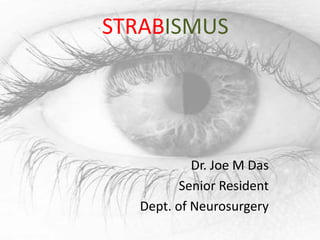This document provides information about strabismus (squinting):
- It affects 7.5 million people in the US and an estimated 130-260 million worldwide. Strabismus occurs when the eyes are not properly aligned on the point of focus.
- The anatomy of the extraocular muscles that control eye movement is described, including the actions of the six muscles and their nerve supply.
- Paralytic squints can be caused by neurogenic or myogenic factors. The document discusses third and fourth nerve palsies as examples. Treatment options for strabismus include optical devices, botulinum toxin injections, orthoptic exercises, and surgery.




























































































